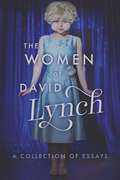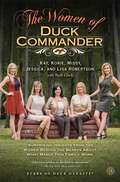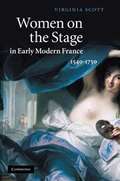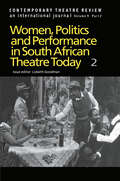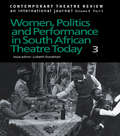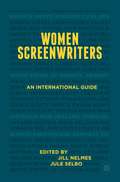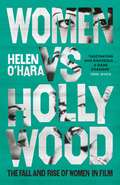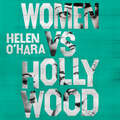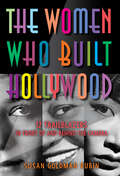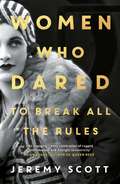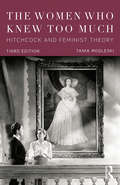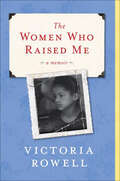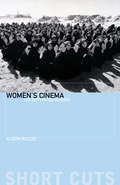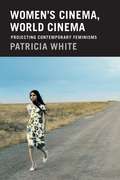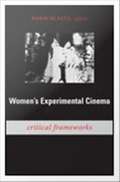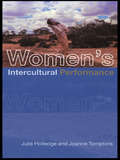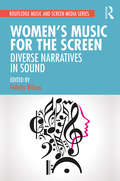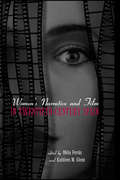- Table View
- List View
Women, Music and Leadership
by Helen RusakWomen, Music and Leadership offers a wide-ranging survey of women in musical leadership and their experiences, highlighting women’s achievements and considering how they negotiate the challenges of the leadership space in music. Women have always participated in music as performers, teachers, composers and professionals, but remain underrepresented in leadership positions. Covering women’s leadership across a wide variety of roles and musical genres, this book addresses women in classical music, gospel, blues, jazz, popular music, electronic music and non-Western musical contexts, and considers women working as composers, as conductors, and in music management and the music business. Each chapter includes several case studies of women’s careers, exploring their groundbreaking contributions to music and the challenges they faced as leaders. Connecting management theory and leadership research with feminist musicology, this book paints a new picture of women’s major contributions as leaders in music and their ongoing struggles for equity. It will be relevant to students and scholars in arts and music management, as well as all those studying music, gender or leadership, and women music professionals.
The Women of David Lynch: A Collection of Essays (The\women Of. . Ser.)
by Scott RyanDavid Lynch, one of America's most misunderstood filmmakers, has for decades had to cope with accusations of misogyny from critics like Roger Ebert, but the funny thing is the women actors who appear in his films almost uniformly love working with him, and the together they have created some of the most fascinating and multidimensional female characters in cinema history, several of whom are celebrated in this anthology of essays by critics, scholars, writers, and fans of the directors work.David Lynch has been accused for decades of sexism and even misogyny in his work, due largely to frequent depictions of violence against women. Yet others see in Lynch&’s work the deification of the female, and actresses like Laura Dern and Naomi Watts jump at every opportunity to work with him. &“He is the master of the juxtaposition of the creepy and the sweet, the sexual and the chaste,&” wrote W&’s Lynn Hirschberg. &“And at the heart of this tense, intriguing friction, you will always find Lynch&’s women.&” The Women of Lynch is a deep, provocative dive into this paradox, featuring twelve essays, thought pieces, and impressionistic interpretations of Lynch&’s depiction of women on screen by an eclectic array of accomplished female critics, scholars, performers, and writers, each tackling this vexing conundrum in her own unique way. It also contains brand new interviews with Lynch actresses Mädchen Amick (Shelly Johnson, Twin Peaks) and Charlotte Stewart (Eraserhead, Twin Peaks) This book contains essays by: x. An Introduction by Philippa Snow 1. "The Uncanny Electricity of David Lynch&’s Women" by Leigh Kellmann Kolb 2. "Women&’s Films: Melodrama and Women&’s Trauma in the Films of David Lynch" by Lindsay Hallam 3. "A Colorless Sky: On the Whiteness of Twin Peaks" by Melanie McFarland 4. "Welcome to the Bipolar Silencio Club!" by Hannah Klein 5. "Warding off the Darkness with Coffee and Pie" by Mallory O'Meara 6. "This is where we talk, Shelly." An Interview with Mädchen Amick by Lindsey Bowden 7. "The Triple Goddess" by Lauren Fox 8. "Isabella Rossellini: The Shocking &“Real&” in Blue Velvet by Kathleen Fleming 9. "Tea And Sympathy: Mrs. Kendal and The Elephant Man" by Rebecca Paller 10. "Jade: Ornamental Gem or Protective Talisman? A Character Study" by Marisa C. Hayes 11. "Mary X Marks The Spot." An Interview with Charlotte Stewart by Lisa Hession 12. "Impressions of Lynch: Journaling a Requiem" by Mya McBriar
The Women of Duck Commander
by Jessica Robertson Lisa Robertson Missy Robertson Kay Robertson Korie RobertsonThe wives of the Robertsons all came into the family the same way: they fell in love with one of the Robertson boys. In the Duck Dynasty TV series, the women often come into their own when the whole family gathers around the table together to eat dinner, and fans of the show get a good glimpse into their lives, but that is hardly the whole story, which is why they decided to write this book... In The Women of Duck Commander, the wives show how they have worked together to help one another and to support the family in all its work and its happiness. They are committed to timeless values, and in the book they share the insights, stories and experiences that have made them who they are. The appeal of the Duck Dynasty comes, not because they are showing us anything new, but they are reminding us of the values our culture is in danger of losing.
Women on Screen
by Melanie WatersA timely intervention into debates on the representation of feminist and feminine identities in contemporary visual culture. The essays in this collection interrogate how and why certain formulations of feminism and femininity are currently prevalent in mainstream cinema and television, offering new insights into postfeminist media phenomena.
Women on Screen: Feminism and Femininity in Visual Culture
by Melanie WatersA timely intervention into debates on the representation of feminist and feminine identities in contemporary visual culture. The essays in this collection interrogate how and why certain formulations of feminism and femininity are currently prevalent in mainstream cinema and television, offering new insights into postfeminist media phenomena.
Women on the Stage in Early Modern France: 1540-1750
by Virginia ScottFocusing on actresses in France during the early modern period, Virginia Scott examines how the stereotype of the actress has been constructed. The study then moves beyond that stereotype to detail the reality of the personal and artistic lives of women on the French stage, from the almost unknown Marie Ferr_ - who signed a contract for 12 livres a year in 1545 to perform the 'antiquailles de Rome or other histories, moralities, farces, and acrobatics' in the provinces - to the queens of the eighteenth-century Paris stage, whose 'adventures' have overshadowed their artistic triumphs. The book also investigates the ways in which actresses made invaluable contributions to the development of the French theatre in the seventeenth and eighteenth centuries, and looks at the 'afterlives' of such women as Armande B_jart, Marquise Du Parc, Charlotte Desmares, Adrienne Lecouvreur, and Hippolyte Clairon in biographies, plays, and films.
Women, Politics and Performance in South African Theatre Today: Volume 2
by Goodman LFirst Published in 1999. Routledge is an imprint of Taylor & Francis, an informa company.
Women, Politics and Performance in South African Theatre Today Vol 3: Volume 3 (Contemporary Theatre Review Ser. #Vols. 9, Pts. 3.)
by Lizbeth GoodmanThis title available in eBook format. Click here for more information.Visit our eBookstore at: www.ebookstore.tandf.co.uk.
Women, Science and Fiction Revisited (Palgrave Studies in Literature, Science and Medicine)
by Debra Benita ShawWomen, Science and Fiction Revisited is an analysis of selected science fiction novels and short stories written by women over the past hundred years from the point of view of their engagement with how science writes the world. Beginning with Charlotte Perkins Gilman's Herland (1918) and ending with N K Jemisin's The City We Became (2020), Debra Benita Shaw explores the re-imagination of gender and race that characterises women's literary crafting of new worlds. Along the way, she introduces new readings of classics like Ursula Le Guin's The Left Hand of Darkness and Margaret Atwood's The Handmaid's Tale, examining the original novels in the context of their adaptation to new media formats in the twenty-first century. What this reveals is a consistent preoccupation with how scientific ideas can be employed to challenge existing social structures and argue for change.
Women Scientists in American Television Comedy: Beakers, Big Bangs and Broken Hearts (Palgrave Studies in Science and Popular Culture)
by Karina Judd Bridget Gaul Anna-Sophie JürgensThis book explores how women scientists are portrayed in hit American TV comedies The Big Bang Theory, Never Have I Ever, and Zoey’s Extraordinary Playlist using a science communication lens. The authors illuminate how comedy, especially irony and satire, communicate complex ideas about gender and science - both reflecting and challenging stereotypes about women in science. Perfect for fans of science, humor, media, and feminism, Women Scientists in American Television Comedy: Beakers, Big Bangs and Broken Hearts highlights the roles science communication, humor and pop culture play in shaping our understanding of women in STEM.
Women Screenwriters: An International Guide
by Jill Nelmes Jule SelboWomen Screenwriters is a study of more than 300 female writers from 60 nations, from the first film scenarios produced in 1986 to the present day. Divided into six sections by continent, the entries give an overview of the history of women screenwriters in each country, as well as individual biographies of its most influential.
Women vs Hollywood: The Fall and Rise of Women in Film
by Helen O'Hara'A fascinating polemic' Sunday Times 'A powerful, sobering and vital work' The Mail on Sunday 'A page-turning read, peppered with humour' Sight & Sound'A must read' Edgar Wright A call to arms from Empire magazine's 'geek queen', Helen O'Hara, that explores women's roles - both in front of and behind the camera - since the birth of Hollywood, how those roles are reflected within wider society and what we can do to level the playing field. Hollywood was born just over a century ago, at a time of huge forward motion for women's rights. With no rules in place to stop them, there were women who forged ahead in many areas of filmmaking. Yet, despite the work of early pioneers like Dorothy Arzner, Mabel Normand, Mary Pickford and Alice Guy-Blaché, it soon came to embody the same old sexist standards. Women found themselves fighting a system that fed on their talent, creativity and beauty but refused to pay them the same respect as their male contemporaries - until now . . . The tide has finally begun to turn. A new generation of women, both in front of and behind the camera, are making waves in the industry and are now shaping some of the biggest films to hit our screens. In Women vs Hollywood: The Fall and Rise of Women in Film, film critic Helen O'Hara takes a closer look at the pioneering and talented women of Hollywood and their work in film since Hollywood began. And in understanding how women were largely written out of Hollywood's own origin story, and how the films we watch are put together, we can finally see how to put an end to a picture that is so deeply unequal - and discover a multitude of stories out there just waiting to be told.
Women vs Hollywood: The Fall and Rise of Women in Film
by Helen O'Hara'A fascinating polemic' Sunday Times'A game changer . . . as inspiring as it is informative' Terri White, editor-in-chief of Empire'An enlightening page-turner' Anna Smith, host of the Girls On Film podcast'This is the film history we need' Pamela Hutchinson, film historian and critic A call to arms from Empire magazine's 'geek queen', Helen O'Hara, that explores women's roles - both in front of and behind the camera - since the birth of Hollywood, how those roles are reflected within wider society and what we can do to level the playing field.The dawn of cinema was a free-for-all, and there were women who forged ahead in many areas of filmmaking. Early pioneers like Dorothy Arzner (who invented the boom mic, among other innovations) and Alice Guy-Blaché shaped the way films are made. But it wasn't long before these talented women were pushed aside and their contributions written out of film history. How and why did this happen?Hollywood was born just over a century ago, at a time of huge forward motion for women's rights, yet it came to embody the same old sexist standards. Women found themselves fighting a system that feeds on their talent, creativity and beauty but refuses to pay them the same respect as their male contemporaries - until now...The tide has finally begun to turn. A new generation of women, both in front of and behind the camera, are making waves in the industry and are now shaping some of the biggest films to hit our screens. There is plenty of work still needed before we can even come close to gender equality in film - but we're finally headed in the right direction.In Women vs Hollywood: The Fall and Rise of Women in Film, Empire's 'geek queen' Helen O'Hara takes a closer look at the pioneering and talented women of Hollywood and their work in film since Hollywood began. Equal representation in film matters because it both reflects and influences wider societal gender norms. In understanding how women were largely written out of Hollywood's own origin story, and how the films we watch are put together, we can finally see how to put an end to a picture that is so deeply unequal - and discover a multitude of stories out there just waiting to be told.
Women vs Hollywood: The Fall and Rise of Women in Film
by Helen O'Hara'A fascinating polemic' Sunday Times 'A powerful, sobering and vital work' The Mail on Sunday 'A page-turning read, peppered with humour' Sight & Sound'A must read' Edgar Wright A call to arms from Empire magazine's 'geek queen', Helen O'Hara, that explores women's roles - both in front of and behind the camera - since the birth of Hollywood, how those roles are reflected within wider society and what we can do to level the playing field. Hollywood was born just over a century ago, at a time of huge forward motion for women's rights. With no rules in place to stop them, there were women who forged ahead in many areas of filmmaking. Yet, despite the work of early pioneers like Dorothy Arzner, Mabel Normand, Mary Pickford and Alice Guy-Blaché, it soon came to embody the same old sexist standards. Women found themselves fighting a system that fed on their talent, creativity and beauty but refused to pay them the same respect as their male contemporaries - until now . . . The tide has finally begun to turn. A new generation of women, both in front of and behind the camera, are making waves in the industry and are now shaping some of the biggest films to hit our screens. In Women vs Hollywood: The Fall and Rise of Women in Film, film critic Helen O'Hara takes a closer look at the pioneering and talented women of Hollywood and their work in film since Hollywood began. And in understanding how women were largely written out of Hollywood's own origin story, and how the films we watch are put together, we can finally see how to put an end to a picture that is so deeply unequal - and discover a multitude of stories out there just waiting to be told.
Women Warriors in Romantic Drama
by Wendy C. NielsenWomen Warriors in Romantic Drama examines a recurring figure that appears in French, British, and German drama between 1789 and 1830: the woman warrior. The term itself, “woman warrior,” refers to quasi-historical female soldiers or assassins. Women have long contributed to military campaigns as canteen women. Camp followers ranged from local citizenry to spouses and prostitutes, and on occasion, women assisted men in combat. However, the woman warrior is a romantic figure, meaning a fanciful ideal, despite the reality of women’s participation in select scenes of the French Revolution and the Napoleonic Wars. The central claim of this book is the woman warrior is a way for some women writers (Olympe de Gouges, Christine Westphalen, Karoline von Günderrode, and Mary Robinson) to explore the case for extending citizenship to women. This project focuses primarily on theater for the reason that the stage simulates the public world that female dramatists and their warriors seek to inhabit. Novels and poetry clearly belong to the realm of fiction, but when audiences see women fighting onstage, they confront concrete visions of impossible women. I examine dramas in the context of their performance and production histories in order to answer why so many serious dramas featuring women warriors fail to find applause, or fail to be staged at all. Dramas about women warriors seem to sometimes contribute to the argument for female citizenship when they take the form of tragedy, because the deaths of female protagonists in such plays often provoke consideration about women’s place in society. Consequently, where we find women playing soldiers in various entertainment venues, farce and satire often seem to dominate, although this book points to some exceptions. Censorship and audience demand for comedies made producing tragedies difficult for female playwrights, who battled additional obstacles to fashioning their careers. I compare male (Edmund Eyre, Heinrich von Kleist) and female writers’ dramatizations of the woman warrior. This analysis shows that the difficult project of getting audiences to take women warriors seriously resembles women writers’ struggles to enter the ostensibly male domains of tragedy and the public sphere. Published by University of Delaware Press. Distributed worldwide by Rutgers University Press.
The Women Who Built Hollywood: 12 Trailblazers in Front of and Behind the Camera
by Susan Goldman RubinDiscover the electrifying untold stories of the pioneering and groundbreaking women of Old Hollywood in this nonfiction book perfect for young movie buffs and budding feminists alike. Includes a foreword written by Marvel Studios' Black Panther and Black Panther: Wakanda Forever Academy Award-Winning Costume Designer Ruth E. Carter.While recent phenomena like #OscarsSoWhite have reminded us that Hollywood can be an unfriendly place to people of color and to women, they have been an integral part of the industry from the beginning. In the early twentieth century, women from all walks of life fought against sexism and racism to succeed in Hollywood as actors, directors, costume designers, editors, and stunt women. From well-known, glamorous starlets like Mary Pickford and Lillian Gish, to under-appreciated trailblazers like Anna May Wong and Hattie McDaniel, acclaimed author Susan Goldman Rubin shows that movies wouldn&’t be the same without the women who succeeded against the odds and built Hollywood from the ground up. Filled with fascinating photographs and little-known facts, this rigorously researched book begins with a foreword by Ruth E Carter, who won Academy Awards in 2019 and 2023 for her work on Marvel Studios' Black Panther and Black Panther: Wakanda Forever.
Women Who Dared: To Break All the Rules
by Jeremy ScottVictoria Woodhull, Mary Wollstonecraft, Aimee Semple McPherson, Edwina Mountbatten, Margaret Argyll and Chanel were all women who dared. They had no time for what society said they could and couldn&’t do and would see the world bend before they did. In 1872 a mesmerising psychic named Victoria Woodhull shattered tradition by running for the White House. Had she won the ensuing spectacle would surely have rivalled that of our own era. Abhorring such flamboyance, Mary Wollstonecraft inspired a revolution of thought with her pen as she issued women&’s first manifesto – still to be fulfilled. From Aimee Semple McPherson, the first female preacher in America, to Coco Chanel, designer of an empire, these women became the change they wanted to see in society. In Women Who Dared, Jeremy Scott pays tribute to them all with wit, verve and reverence.
The Women Who Knew Too Much: Hitchcock and Feminist Theory
by Tania ModleskiOriginally published in 1988, The Women Who Knew Too Much remains a classic work in film theory and feminist criticism. The book consists of a theoretical introduction and analyses of seven important films by Alfred Hitchcock, each of which provides a basis for an analysis of the female spectator as well as of the male spectator. Modleski considers the emotional and psychic investments of men and women in female characters whose stories often undermine the mastery of the cinematic "master of suspense." The third edition features an interview with the author by David Greven, in which he and Modleski reflect on how feminist and queer approaches to Hitchcock studies may be brought into dialogue. A teaching guide and discussion questions by Ned Schantz help instructors and students to delve into this seminal work of feminist film theory.
The Women Who Raised Me: A Memoir
by Victoria RowellBorn as a ward of the state of Maine, the child of an unmarried Yankee blueblood mother and an unknown black father, Victoria Rowell beat the odds. The Women Who Raised Me is the remarkable story of her rise out of the foster care system to attain the American Dream—and of the unlikely series of women who lifted, motivated, and inspired her along the way.From Agatha Armstead—a black Bostonian who was Victoria's longest-term foster mother and first noticed her spark of creativity and talent—to Esther Brooks, a Paris-trained prima ballerina who would become her first mentor at the Cambridge School of Ballet—The Women Who Raised Me is a loving, vivid portrait of all the women who would help Victoria transition out of foster care and into New York City's wild worlds of ballet, acting, and adulthood. Though Victoria would go on to become an accomplished television and film star, she still carried the burden of loneliness and anxiety, particularly common to those "orphans of the living" who are never adopted. Vividly recalled and candidly told, her story is transfixing, redemptive, heartbreaking, and, ultimately, inspiring.
Women's Cinema: The Contested Screen (Short Cuts)
by Alison ButlerWomen's Cinema provides an introduction to critical debates around women's filmmaking and relates those debates to a variety of cinematic practices. Taking her cue from the groundbreaking theories of Claire Johnston, Alison Butler argues that women's cinema is a minor cinema that exists inside other cinemas, inflecting and contesting the codes and systems of the major cinematic traditions from within. Using canonical directors and less established names, ranging from Chantal Akerman to Moufida Tlatli, as examples, Butler argues that women's cinema is unified in spite of its diversity by the ways in which it reworks cinematic conventions.
Women’s Cinema, World Cinema: Projecting Contemporary Feminisms
by Patricia WhiteIn Women's Cinema, World Cinema, Patricia White explores the dynamic intersection of feminism and film in the twenty-first century by highlighting the work of a new generation of women directors from around the world: Samira and Hana Makhmalbaf, Nadine Labaki, Zero Chou, Jasmila Zbanic, and Claudia Llosa, among others. The emergence of a globalized network of film festivals has enabled these young directors to make and circulate films that are changing the aesthetics and politics of art house cinema and challenging feminist genealogies. Extending formal analysis to the production and reception contexts of a variety of feature films, White explores how women filmmakers are both implicated in and critique gendered concepts of authorship, taste, genre, national identity, and human rights. Women's Cinema, World Cinema revitalizes feminist film studies as it argues for an alternative vision of global media culture.
Women’s Experimental Cinema: Critical Frameworks
by Noel Carroll Christine Holmlund Paul Arthur Robin Blaetz Melissa RagonaWomen's Experimental Cinema provides lively introductions to the work of fifteen avant-garde women filmmakers, some of whom worked as early as the 1950s and many of whom are still working today. In each essay in this collection, a leading film scholar considers a single filmmaker, supplying biographical information, analyzing various influences on her work, examining the development of her corpus, and interpreting a significant number of individual films. The essays rescue the work of critically neglected but influential women filmmakers for teaching, further study, and, hopefully, restoration and preservation. Just as importantly, they enrich the understanding of feminism in cinema and expand the terrain of film history, particularly the history of the American avant-garde.The contributors examine the work of Marie Menken, Joyce Wieland, Gunvor Nelson, Yvonne Rainer, Carolee Schneemann, Barbara Rubin, Amy Greenfield, Barbara Hammer, Chick Strand, Marjorie Keller, Leslie Thornton, Abigail Child, Peggy Ahwesh, Su Friedrich, and Cheryl Dunye. The essays highlight the diversity in these filmmakers' forms and methods, covering topics such as how Menken used film as a way to rethink the transition from abstract expressionism to Pop Art in the 1950s and 1960s, how Rubin both objectified the body and investigated the filmic apparatus that enabled that objectification in her film Christmas on Earth (1963), and how Dunye uses film to explore her own identity as a black lesbian artist. At the same time, the essays reveal commonalities, including a tendency toward documentary rather than fiction and a commitment to nonhierarchical, collaborative production practices. The volume's final essay focuses explicitly on teaching women's experimental films, addressing logistical concerns (how to acquire the films and secure proper viewing spaces) and extending the range of the book by suggesting alternative films for classroom use.Contributors. Paul Arthur, Robin Blaetz, Noël Carroll, Janet Cutler, Mary Ann Doane, Robert A. Haller, Chris Holmlund, Chuck Kleinhans, Scott MacDonald, Kathleen McHugh, Ara Osterweil, Maria Pramaggiore, Melissa Ragona, Kathryn Ramey, M. M. Serra, Maureen Turim, William C. Wees
Women's Intercultural Performance
by Julie Holledge Joanne TompkinsThis is the first in-depth examination of contemporary intercultural performance by women around the world. Contemporary feminist performance is explored in the contexts of current intercultural practices, theories and debates. Holledge and Tompkins provide ways of thinking about and analysing contemporary performance and representations of the performing, female, culturally-marked body. The book includes discussions of: * ritual performance by women from Central Australia and Korea * the cultural exchange of A Doll's House and Antigone * plays from Algeria, South Africa and Ghana * the work of the Takarazuka revue company * the market forces that govern the distribution of women and women's performance. This is an essential read for anyone studying or interested in women's performance.
Women's Music for the Screen: Diverse Narratives in Sound
by Felicity WilcoxWomen’s Music for the Screen: Diverse Narratives in Sound shines a long-overdue light on the works and lives of female-identifying screen composers. Bringing together composer profiles, exclusive interview excerpts, and industry case studies, this volume showcases their achievements and reflects on the systemic gender biases women have faced in an industry that has long excluded them. Across 16 essays, an international array of contributors present a wealth of research data, biographical content, and musical analysis of film, television, and video game scores to understand how the industry excludes women, the consequences of these deficits, and why such inequities persist – and to document women’s rich contributions to screen music in diverse styles and genres.The chapters amplify the voices of women composers including Bebe Barron, Delia Derbyshire, Wendy Carlos, Anne Dudley, Rachel Portman, Hildur Guðnadóttir, Mica Levi, Winifred Phillips, and more. From the mid-twentieth century to the present, and from classic Hollywood scores to pioneering electronic music, these are the stories and achievements of the women who have managed to forge successful careers in a male-dominated arena. Suitable for researchers, educators, and students alike, Women’s Music for the Screen urges the screen music industry to consider these sounds and stories in a way it hasn’t before: as voices that more accurately reflect the world we all share.
Women's Narrative and Film in 20th Century Spain
by Kathleen GlennWomen's Narrative and Film in 20th Century Spain examines the development of the feminine cultural tradition in spain and how this tradition reshaped and defined a Spanish national identity. Each chapter focuses on representation of autobiography, alienation and exile, marginality, race, eroticism, political activism, and feminism within the ever-changing nationalisms in different regions of Spain. The book describes how concepts of gender and difference shaped the individual, collective, and national identities of Spanish women and significantly modified the meaning and representation of female sexuality.

